
Hunter ceiling fan remotes are handy little gadgets. Most are pretty simple—plastic, a few buttons, maybe a slider. But when their range starts acting up, the convenience vanishes in a hurry. You shouldn’t have to play “hot and cold” just to get your fan spinning at the right speed or to dim the light before bedtime. Here’s the thing: range problems are more common than you’d think, and they’re usually fixable with a little know-how (and maybe some fresh batteries).
Understanding How a Hunter Ceiling Fan Remote Works
Let’s start at the basics. Imagine your ceiling fan remote as a tiny walkie-talkie. It sends signals—usually by radio frequency (RF)—to a receiver tucked inside the fan’s housing. Think of the *receiver* as a tiny mailbox for your remote’s messages. When you press a button to turn the fan on or off, the remote sends a unique code, and the receiver listens for this code to know what to do.
Unlike old-school infrared (IR) remotes (think early TV clickers), most Hunter ceiling fan remotes use RF. That means you generally don’t need a clear “line of sight” to make things work. But the signal can still get blocked or weakened by things like thick walls, metal beams, or even big piles of…well, stuff. Honestly, some homes are just trickier than others. So if your remote’s range is spotty, that’s your first clue: something is blocking or scrambling the signal between the remote and the receiver.
It’s worth mentioning that not every Hunter fan uses the same frequency, or even the same kind of remote. Some can be paired and reset; others rely on fixed *dip switches*—tiny toggles inside the remote and receiver for syncing up. So, knowing which version you have helps a lot when it’s time to troubleshoot.
Common Causes of Hunter Ceiling Fan Remote Range Issues
You might be wondering, why would a remote suddenly lose range? It’s almost always one of a few culprits. Here are some of the most common:
- Dead or Weak Batteries: This might sound obvious, but low battery power is the most frequent cause of poor remote range. When the battery’s low, the remote can’t “shout” its signal as far. Even if it lights up, it may not be reaching the fan.
- Signal Interference: RF signals are everywhere—WiFi, microwaves, wireless doorbells. If too many things are crowding the airwaves, your remote’s little message gets drowned out.
- Physical Barriers: Thick walls, metal ducts, or even large mirrors can block or weaken the signal between your remote and receiver. Sometimes even standing in the way can make a difference.
- Receiver Issues: If the receiver inside your fan is loose, damaged, or has its wires tangled, even a perfect signal won’t go far.
Honestly, nobody thinks their piles of laundry or their neighbor’s WiFi could mess with a ceiling fan. But these things sneak up on you. That’s why it’s helpful to look around and see if anything in your room changed recently before panicking about a broken remote.
Step-By-Step: Troubleshooting Hunter Ceiling Fan Remote Range
Okay, let’s get hands-on. Here’s what to do if your Hunter fan remote isn’t working from across the room—or only seems to work when you’re standing on a chair directly under the blades.
- Start with the batteries: Take out the old batteries and pop in fresh, high-quality ones. Don’t rely on batteries that have been rolling around your junk drawer for a year. Even if the power indicator lights up on the remote, swapping out batteries can make a huge difference.
- Move closer and test: Stand right under the fan and try each function. If it works up close but not far away, you’re probably dealing with a weak signal—not a totally broken remote.
- Look for barriers: Is your fan installed near metal beams, air ducts, or a thick wall? Even a big piece of furniture or a mirror can affect things. Try moving obstacles if possible, or work around them by repositioning the receiver inside the canopy.
- Check for interference: Are there a ton of other wireless devices in your home office or living room? Routers, smart speakers, even wireless headphones can cause interference. Try turning off other devices briefly to see if the range improves.
- Inspect the receiver connections: For those comfortable with a screwdriver, turn off power at the breaker, remove the canopy, and check if the receiver’s wires are loose or pinched. Sometimes, a simple repositioning can clear up signal woes.
If your remote only works sporadically, or loses range after a few days, don’t just bang it on your palm (tempting, I know). Go through these steps patiently—most issues can be fixed without calling an electrician.
How to Reset and Sync a Hunter Ceiling Fan Remote
Here’s where things get a bit technical. Sometimes, your remote and receiver just fall out of “sync”—almost like an old married couple who stopped talking. Resetting and pairing the remote and receiver can fix a lot of range problems, especially after changing batteries or moving the fan.
- Find the pairing button: On most Hunter remotes, there’s a tiny button hidden inside the battery compartment. You might need a paperclip to press it.
- Power cycle the fan: Turn the fan off at the wall switch or breaker for about 10 seconds, then turn it back on. This wakes the receiver up and makes it ready to pair.
- Press and hold to pair: Hold down the pairing or reset button on the remote for 3–5 seconds while standing near the fan. The fan’s lights or blades should move briefly to confirm pairing.
- Test the range again: Walk around the room and press the buttons. If the range is better, you’ve done it right. If not, try syncing again or move a little closer to the fan when pairing.
Some Hunter fans use dip switches instead of “smart” pairing. These are tiny toggles inside both the remote and the receiver. They need to match up exactly for the signal to travel at all. If you’ve changed anything inside the remote, or replaced it, double-check that those switches match.
Tip: Always check your fan’s manual or Hunter’s official website for specific code, sync, and reset instructions for your model. Not all fans use the same process.
Comparing Universal Remotes vs Hunter-Specific Remotes
Maybe you picked up a universal ceiling fan remote from the hardware store, hoping for a quick fix. Here’s where things can get tricky. Universal remotes sound simple, but they often don’t play perfectly with Hunter receivers. Why? Because the codes—the little “passwords” the remote sends—aren’t always compatible.
With a Hunter-specific remote, you’re almost guaranteed a better, longer range because the code matches up perfectly with the built-in receiver. Many universal remotes do work, but you’ll likely have to spend a little more time syncing, resetting, or fiddling with dip switches.
If you’re troubleshooting range issues with a universal remote, the same steps above apply—but success isn’t always guaranteed. If your remote cuts out at 5 feet, and you’ve already reset, changed batteries, and checked for interference, it might be time to switch back to an official Hunter remote.
Honestly, it might feel like you’re saving money with a universal remote at first, but when every click is a gamble, the convenience fades fast.
Signs You May Need a Replacement Hunter Remote or Receiver
Sometimes, no matter what you do, the remote just won’t cooperate. If you’ve:
- Replaced the batteries (multiple times)
- Reset and resynced everything
- Checked for interference and moved obstacles
- Matched dip switches perfectly
…and the remote still only works at close range (or not at all), there may be a deeper issue. Remotes can wear out, especially if dropped repeatedly or exposed to humidity. Receivers inside the fan aren’t immune either—power surges, heat, or loose wiring can knock them out.
You might notice odd symptoms: the fan responds to one button but ignores others, the light flickers, or the remote feels “dead” even with fresh batteries. When that happens, replacing just the remote, or both the remote and receiver (Hunter sells kits for this), is usually the fastest fix. If in doubt, calling Hunter support or a licensed electrician isn’t the worst idea in the world.
Preventing Future Range Problems With Your Hunter Ceiling Fan Remote
No one wants to relive this troubleshooting dance every few months. Here are some simple ways to keep your Hunter remote working at its best:
- Use fresh, high-quality batteries—preferably alkaline, and swap them out at the first sign of lag.
- Keep the remote and fan’s receiver as “visible” to each other as possible (don’t bury the receiver deep inside metal housing if you can avoid it).
- Avoid stacking wireless gadgets right on top of each other, especially if you notice interference.
- Dust the remote and keep it dry—moisture and grit can wear out the buttons over time.
- If you’re renovating or moving big furniture, watch for new barriers between your couch and your fan.
It sounds small, but these habits add up. Kind of like flossing your teeth—easy to skip, but way better than dealing with a bigger problem later.
When To Consider Professional Help
Most range issues with Hunter ceiling fan remotes are DIY-friendly. But there are times when it’s smarter (and safer) to bring in the pros. For example, if you open up the fan canopy and see frayed or burnt wires, it’s time to stop and consult an electrician. Messing with in-ceiling wiring isn’t worth risking a shock or a fire.
Also, if you’ve tried *everything*—new remotes, battery swaps, resets, even buying an official Hunter replacement—and your fan still won’t respond from more than a couple feet away, a professional can test the wiring and the receiver with the right gear. Sometimes, there’s a deeper electrical issue at play.
And if your fan is still under warranty, reach out to Hunter’s customer support first. They’ll often walk you through advanced troubleshooting steps or send you a replacement if it’s a known issue.
When in doubt, don’t poke around inside the fan if you’re not sure what you’re doing. There’s no shame in calling for help.
Final Thoughts: Keeping Your Hunter Ceiling Fan Remote Reliable
At the end of the day, a ceiling fan remote should make your life easier—not turn into a scavenger hunt for the “magic spot” where the buttons finally work. Most range problems come down to batteries, signal interference, or a quick reset. Every once in a while, it’s something more complex, but you won’t know until you work through the basics slowly and patiently.
Taking a few minutes to understand how your Hunter ceiling fan remote works, and how to troubleshoot it, pays off every time you grab the remote and expect the lights and blades to obey instantly. Keep those batteries fresh, keep the path clear, and don’t hesitate to reset or resync when needed. With a little extra care, you’ll spend a lot more time enjoying a cool breeze—and a lot less time waving your remote in frustration.
